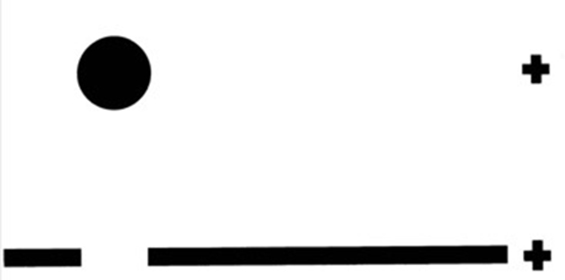Thursday, 11 February 2021
Revisiting an optical illusion in terms of predictive processing
 I recently came across a little experiment that I posted years ago on this website to show how the blind spot in each of your eyes works. The blind spot is a part of the retina where there are no photoreceptors, because it is where the axons of the retina’s ganglion cells converge and exit the eye, forming the optical nerve. As a result, there’s a corresponding area in your field of vision that doesn’t register on the retina. Hence, in theory, you shouldn’t see anything there. But in reality, you don’t see any such blank spot in your field of vision.
I recently came across a little experiment that I posted years ago on this website to show how the blind spot in each of your eyes works. The blind spot is a part of the retina where there are no photoreceptors, because it is where the axons of the retina’s ganglion cells converge and exit the eye, forming the optical nerve. As a result, there’s a corresponding area in your field of vision that doesn’t register on the retina. Hence, in theory, you shouldn’t see anything there. But in reality, you don’t see any such blank spot in your field of vision.
To find out why not, let’s revisit this optical illusion from the standpoint of predictive-processing theory, which has become more and more accepted in cognitive science over the past 10 years or so. In the traditional view, the brain passively waits to receive inputs, then processes them and ultimately produces outputs, as if it were nothing more than a biologically based computer. In contrast, according to predictive-processing theory, the brain is a proactive organ that is constantly making predictions about its environment and what may be about to happen there, so as to operate within it more effectively.
According to predictive-processing theory, the reason that you don’t notice your blind spot is that your brain makes you blind, so to speak, to the blindness in that part of your field of vision. It does so by filling this area in with the visual information that is most likely to occur there, according to the experience of the world stored in your memory.
The two graphics above give you two ways of experiencing your blind spot.
For the top graphic, close your right eye, look at the + sign with your left eye, then move your head toward or away from the screen slowly while continuing to watch the + sign. The big black dot will disappear as it passes through the blind spot of the retina of your left eye, because your brain projects the surrounding white background onto the corresponding spot in your field of vision.
For the bottom graphic, do the same thing. This time, when the image is at the right distance from your eye, the two lines will look like one solid line. This seems like pure magic, until you apply the theory of predictive processing to explain it: the brain predicts what is most likely to appear in the space between the two lines—a continuation of them—and inserts it there!
You can readily imagine the evolutionary advantages of your brain’s operating in this way. Most of the signals that it receives from the outside world involve a certain degree of ambiguity. If your brain couldn’t project its predictions about the world based on your past experiences, you might, for example, have to wait until the catlike form jumped out of the high grass on the trail ahead of you before you recognized it as a tiger. By then it would probably be too late to run. If your humanoid ancestors’ brains had worked like that, you might not be around here now to worry about it.
The Senses | Comments Closed








